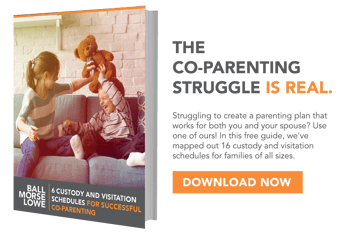
When preparing for a child custody case or even just considering the possibility, it’s crucial to understand the various outcomes that may occur. There are two main, general types of custody with different versions of each one. Those two types are physical custody of the child and legal custody of the child.
First, if you don’t already know, physical custody does not necessarily mean total responsibility for the child or children. Physical custody of the child only refers to which parent the child lives with. Legal custody of the child includes which parent makes decisions on behalf of the child. These decisions may include, but also are not limited to, decisions from medical choices to religious groups to where they attend school.
There are several outcomes within physical custody which should be discussed and considered before starting the process of your child custody case.
(If you need more detailed information about custody, download our free guide child custody today)
Sole Custody
Parents who receive sole custody of their child receive exactly what that sounds like: only one parent receives complete custody of both physical and legal aspects of the child or children’s lives. This means that the child will live with only one parent and only one parent will choose where the child goes to school, where their healthcare comes from, and even what religious or extracurricular activities the child participates in.
Most of the time, sole custody is awarded because one parent has been proven a bad fit for the child for reasons ranging from being absent in their life to the possibility of abuse or neglect. If you’re seeking sole custody, you’ll need a compelling case as to why you receiving sole custody is in the best interest of the child.
Sole Physical Custody
Like complete sole custody, in this scenario, the child lives with only one parent or guardian, called the primary custodial parent. However, as you’ll note, the key difference is that this does not include sole legal custody. In this case, the custodial agreement states that one parent is responsible for the physical home of the child, while both parents continue to share the responsibility of the legal needs of the child or children.
When the parents continue sharing legal custody, typically the physical custodian’s home is the child’s home at least 50 percent of the time, if not more. When one parent has sole physical custody, the other often still has reasonable visitation rights.
Split Physical Custody
Speaking of reasonable visitation rights, there is also split physical custody, wherein both parents share the responsibility of giving the child or children a home. Like split legal custody, which is usually granted when one parent earns sole physical custody, this option does not necessarily mean that the legal custody is split.
In most cases of split physical custody of the child, this is granted and agreed upon because of an amicable split, and unless the court finds reason to do otherwise, it is a relatively painless process for all involved. One frequent instance in which this does not get granted when both parents have decided upon it is if the judge deems one parent unfit to meet these terms.
Joint Physical Custody
Joint physical custody is very similar to split custody with just a few key differences. For one, joint custody, or shared custody (not the exact same, but close enough to fall under the same category), is usually even more amicable than split physical custody. More and more, judges are refusing split custody in favor of joint custody. It is often in the best interest of the child to spend equal time with both parents.
In this case, the parents lay out a schedule for their child or children to see them nearly equally. This means both parents need an adequate living space, an agreed upon school district, and proper child support agreements in place as well. This arrangement is one of the most ideal for the child or children as they get to see their parents often, but in some cases it can be even worse for them as it means their lives are in constant flux. The custodial agreement will clearly explain the entire schedule.
Physical Custody of the Child With Visitation
Almost all of the aforementioned case outcomes result in some visitation. Yet, what we’re talking about here is a scenario in which one parent is granted sole custody but the other one receives scheduled visitation hours as part of the custodial agreement. Usually, this time of visitation is strict. In this case, it’s common for one parent to have the child most of the time, except for every other weekend and specifically listed holidays. The custody arrangements are explicitly explained as part of the custody agreement so that the parents are clear on what is expected of them.
This is a scenario which works best when one parent has a more stable home, or in a temporary aspect after a divorce, when one parent is trying to move into a new place and thus is not yet prepared to house a child or children.
In Summary
Physical custody is different from legal custody and comes with many of its own specific rules. It’s highly recommended that, unless you are skilled in legal practice, you consult with an attorney before taking action and filing a child custody case. It is important to note that custody is defined by the amount of overnights the child is spending in respective house households versus having hours of visitation. The more nights a child spends with a parent, the less their child support obligation as well as the more parenting time they receive credit for.
To learn more about how to go about filing for child custody in Oklahoma, contact us now, or download our free guide today.
.png)

